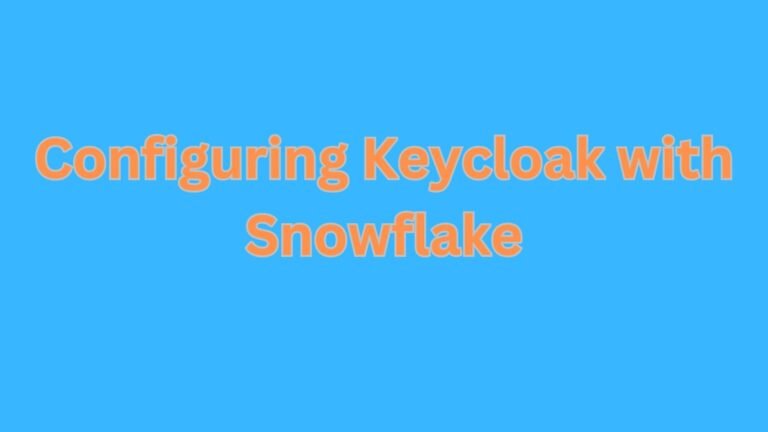In today’s digital landscape, managing user identities and ensuring secure access to applications are paramount for businesses. Keycloak, an open-source identity and access management solution, is widely recognized for its robust capabilities in managing user authentication and authorization. Snowflake, a cloud-based data warehousing platform, allows organizations to efficiently store and analyze data. Integrating Keycloak with Snowflake enables organizations to streamline access control while leveraging the powerful data analytics capabilities of Snowflake. This article will provide a detailed, step-by-step guide on configuring Keycloak with Snowflake, ensuring a secure and efficient identity management system.
What is Keycloak?
Keycloak is an open-source identity and access management solution developed by Red Hat. It provides features such as single sign-on (SSO), identity brokering, user federation, and more. Keycloak allows organizations to manage user authentication and authorization for applications easily, ensuring secure access to resources. With its flexible architecture, Keycloak supports various authentication methods, including social login, two-factor authentication, and customizable login pages.
What is Snowflake?
Snowflake is a cloud-based data platform that provides data warehousing, analytics, and sharing capabilities. Unlike traditional data warehouses, Snowflake allows organizations to separate compute and storage, providing flexibility and scalability for data analytics. Snowflake’s unique architecture enables organizations to efficiently manage large datasets and perform complex queries without the need for extensive infrastructure management.
Why Integrate Keycloak with Snowflake?
Integrating Keycloak with Snowflake offers several benefits:
Centralized Authentication: Keycloak provides a centralized authentication mechanism for Snowflake, allowing users to log in with their credentials seamlessly.
Enhanced Security: By leveraging Keycloak’s robust security features, organizations can enhance the security of their Snowflake environment.
Simplified User Management: Keycloak allows organizations to manage users, roles, and permissions efficiently, simplifying access control for Snowflake resources.
Compliance and Auditing: Keycloak provides features for tracking user activities and ensuring compliance with data protection regulations.
Prerequisites for Integration
Before configuring Keycloak with Snowflake, ensure you have the following:
A Snowflake account with appropriate access rights.
A Keycloak instance running and accessible.
Administrative privileges on both Keycloak and Snowflake.
Step-by-Step Guide to Configure Keycloak with Snowflake
Create a Snowflake User
Log in to your Snowflake account.
Navigate to the Users section in the Snowflake console.
Click on Create to create a new user.
Specify the required details, including username, password, and roles. Make a note of the user’s credentials for later use.
Set Up Keycloak
Install Keycloak: If you haven’t installed Keycloak yet, you can do so by following the official installation guide.
Access Keycloak Admin Console: Once Keycloak is installed, access the admin console at http://<your-keycloak-domain>:8080/auth/admin.
Create a Realm:
In the Keycloak admin console, click on the Add Realm button.
Enter a name for the realm (e.g., “SnowflakeRealm”).
Click Create to set up the realm.
Configure a Client in Keycloak
In your newly created realm, navigate to the Clients section.
Click on Create to set up a new client.
Enter the following details:
Client ID: Choose a unique identifier (e.g., “snowflake-client”).
Client Protocol: Select openid-connect.
Root URL: Enter the URL of your Snowflake account (e.g., https://<your-snowflake-account>.snowflakecomputing.com).
Configure Client Settings
After saving the client, navigate to the Settings tab.
Configure the following settings:
Access Type: Set to confidential.
Valid Redirect URIs: Specify the redirect URI for your Snowflake account.
Web Origins: Set this to * to allow all origins or specify your domain.
Set Up Client Authentication
Navigate to the Credentials tab of your client.
Copy the Client Secret; you will need this for configuring Snowflake.
Create Users in Keycloak
Go to the Users section in your realm.
Click on Add User to create users who will access Snowflake.
Fill in the user details and click Save.
Navigate to the Credentials tab to set a password for the user.
Map Roles to Users
Go to the Roles section in your realm.
Click on Add Role to create roles that correspond to Snowflake roles (e.g., “snowflake_read”, “snowflake_write”).
After creating roles, navigate back to the user’s profile and assign the created roles.
Configure Snowflake for Keycloak Authentication
Log in to your Snowflake account.
Navigate to the Account section and click on Integrations.
Click on Create to set up a new OAuth integration.
Fill in the following details:
Name: Provide a name for the integration (e.g., “KeycloakIntegration”).
Type: Set to OAUTH.
Enabled: Set to True.
Click Create to save the integration.
Configure OAuth Parameters
In the OAuth integration, set the following parameters:
Authorization Endpoint: Set to http://<your-keycloak-domain>:8080/auth/realms/<your-realm>/protocol/openid-connect/auth.
Token Endpoint: Set to http://<your-keycloak-domain>:8080/auth/realms/<your-realm>/protocol/openid-connect/token.
Client ID: Use the client ID you set in Keycloak.
Client Secret: Paste the client secret copied earlier.
Click Save to apply the changes.
Test the Integration
Open a new browser window and navigate to your Snowflake account.
Attempt to log in using the Keycloak credentials you created.
If configured correctly, you should be redirected to the Keycloak login page. After entering the credentials, you will be redirected back to Snowflake.
Conclusion
Integrating Keycloak with Snowflake enhances your organization’s security posture while streamlining user access management. This guide provided a comprehensive overview of the steps needed to configure Keycloak with Snowflake, from setting up realms and clients in Keycloak to configuring OAuth integration in Snowflake. By leveraging Keycloak’s robust identity management features, organizations can ensure secure and efficient access to their Snowflake data, enabling better data-driven decision-making.
ALSO READ:Best No Code Data Select Scrape Software 2024: Effortless Data Extraction Solutions
FAQs
What are the key benefits of using Keycloak with Snowflake?
The integration provides centralized authentication, enhanced security, simplified user management, and compliance auditing.
Is Keycloak open-source?
Yes, Keycloak is an open-source identity and access management solution.
Can I use Keycloak with other applications besides Snowflake?
Yes, Keycloak can be integrated with various applications and services that support OAuth 2.0 and OpenID Connect protocols.
What happens if a user forgets their Keycloak password?
Keycloak provides a password reset feature that allows users to reset their passwords securely.
Are there any costs associated with using Keycloak?
Keycloak is open-source and free to use. However, costs may arise from hosting and maintaining the Keycloak server.

